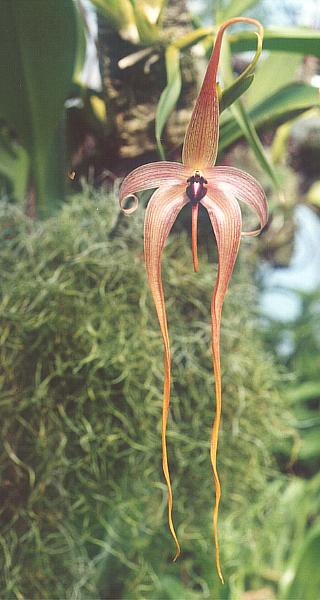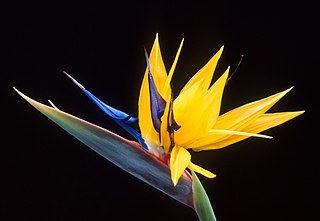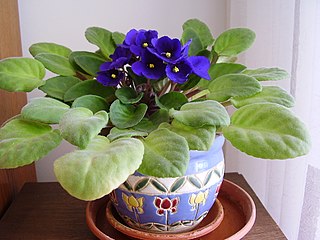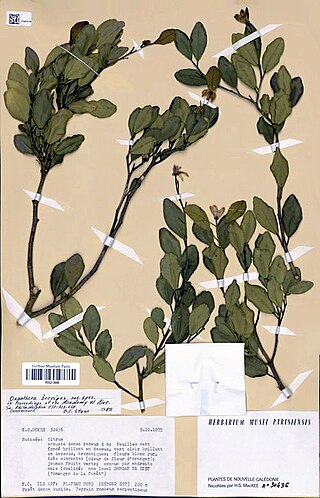
The Santalales are an order of flowering plants in the dicotyledons. Well-known members of the Santalales include sandalwoods and the many species of mistletoes. The order has a cosmopolitan distribution, but is heavily concentrated in tropical and subtropical regions. It derives its name from its type genus, Santalum (sandalwood).

Bulbophyllum is a genus of mostly epiphytic and lithophytic orchids in the family Orchidaceae. It is the largest genus in the orchid family and one of the largest genera of flowering plants with more than 2,000 species, exceeded in number only by Astragalus. These orchids are found in diverse habitats throughout most of the warmer parts of the world including Africa, southern Asia, Latin America, the West Indies, and various islands in the Indian and Pacific Oceans. Orchids in this genus have thread-like or fibrous roots that creep over the surface of trees or rocks or hang from branches. The stem is divided into a rhizome and a pseudobulb, a feature that distinguished this genus from Dendrobium. There is usually only a single leaf at the top of the pseudobulb and from one to many flowers are arranged along an unbranched flowering stem that arises from the base of the pseudobulb. Several attempts have been made to separate Bulbophyllum into smaller genera, but most have not been accepted by the World Checklist of Selected Plant Families.

Strelitzia is a genus of five species of perennial plants, native to South Africa. It belongs to the plant family Strelitziaceae. A common name of the genus is bird of paradise flower/plant, because of a resemblance of its flowers to birds-of-paradise. In South Africa, it is commonly known as a crane flower.

Gesneriaceae, the gesneriad family, is a family of flowering plants consisting of about 152 genera and ca. 3,540 species in the tropics and subtropics of the Old World and the New World, with a very small number extending to temperate areas. Many species have colorful and showy flowers and are cultivated as ornamental plants.

Joseph Marie Henry Alfred Perrier de la Bâthie was a French botanist who specialized in the plants of Madagascar.

Linaceae is a family of flowering plants. The family is cosmopolitan, and includes about 250 species in 14 genera, classified into two subfamilies: the Linoideae and Hugonioideae. Leaves of the Linaceae are always simple; arrangement varies from alternate to opposite or whorled. The hermaphroditic, actinomorphic flowers are pentameric or, very rarely, tetrameric.

Nyctaginaceae, the four o'clock family, is a family of around 33 genera and 290 species of flowering plants, widely distributed in tropical and subtropical regions, with a few representatives in temperate regions. The family has a distinctive fruit type called an accessory fruit or anthocarp, and many genera have extremely large pollen grains.

Triadenum, known as marsh St. John's worts, is a small genus of flowering plants in the family Hypericaceae. The genus is characterized by opposite, blunt-tipped leaves and pink flowers with 9 stamens. They are distributed in North America and eastern Asia.

Selenicereus, sometimes known as moonlight cactus, is a genus of epiphytic, lithophytic, and terrestrial cacti, found in Mexico, Central America, the Caribbean and northern South America. The term night-blooming cereus is also sometimes used, but this is also used for many night-blooming cacti, including Epiphyllum and Peniocereus. In 2017, the genus Hylocereus was brought into synonymy with Selenicereus. A number of species of Selenicereus produce fruit that is eaten. The fruit, known as pitaya or pitahaya in Spanish or as dragon fruit, may be collected from the wild or the plants may be cultivated.
George Don was a Scottish botanist and plant collector.

Asparagaceae, known as the asparagus family, is a family of flowering plants, placed in the order Asparagales of the monocots. The family name is based on the edible garden asparagus, Asparagus officinalis. This family includes both common garden plants as well as common houseplants. The garden plants include asparagus, yucca, bluebell, and hosta, and the houseplants include snake plant, corn cane, spider plant, and plumosus fern.

Bromelioideae is a subfamily of the bromeliads (Bromeliaceae). This subfamily is the most diverse in the family, represented by the greatest number of genera with about 40. Most of the plants in this group are epiphytes, though some have evolved in, or will adapt to, terrestrial conditions. This subfamily features the most plant types which are commonly cultivated by people, including the pineapple.

Oxanthera brevipes is a species of plant in the family Rutaceae. It is endemic to New Caledonia. It was proposed as a novel species by Benjamin C. Stone based on two specimens, distinguished from other false oranges by a non-articulated petiole. The genus Oxanthera has been synonymized with Citrus, but a name in Citrus does not appear to have been published, and Plants of the World Online regards "Oxanthera brevipes" as an unplaced name.

I. M. Johnston was a United States botanist. He studied at Pomona College in Claremont, California and at Harvard University. His plant collections are housed in the Rancho Santa Ana Botanic Garden, in Claremont, and also in the Gray Herbarium of Harvard University. His areas of interest included Pteridophytes and Spermatophytes.

Paul Carpenter Standley was an American botanist known for his work on neotropical plants.
Julian Alfred Steyermark was a Venezuelan American botanist. His focus was on New World vegetation, and he specialized in the family Rubiaceae.

Ludwig Adolph Timotheus Radlkofer, was a Bavarian taxonomist and botanist.
Conrad Vernon Morton was an American botanist, who did notable writings on ferns. He was also a specialist in Gesneriaceae and Solanaceae for the Smithsonian Institution from 1928.

Lumnitzera is an Indo-West Pacific mangrove genus in the family Combretaceae. An English common name is black mangrove. Lumnitzera, named after the German botanist, Stephan Lumnitzer (1750-1806), occurs in mangroves from East Africa to the Western Pacific, and northern Australia.
Sidney Fay Blake (1892–1959) was an American botanist and plant taxonomist, "recognized as one of the world's experts on botanical nomenclature."














